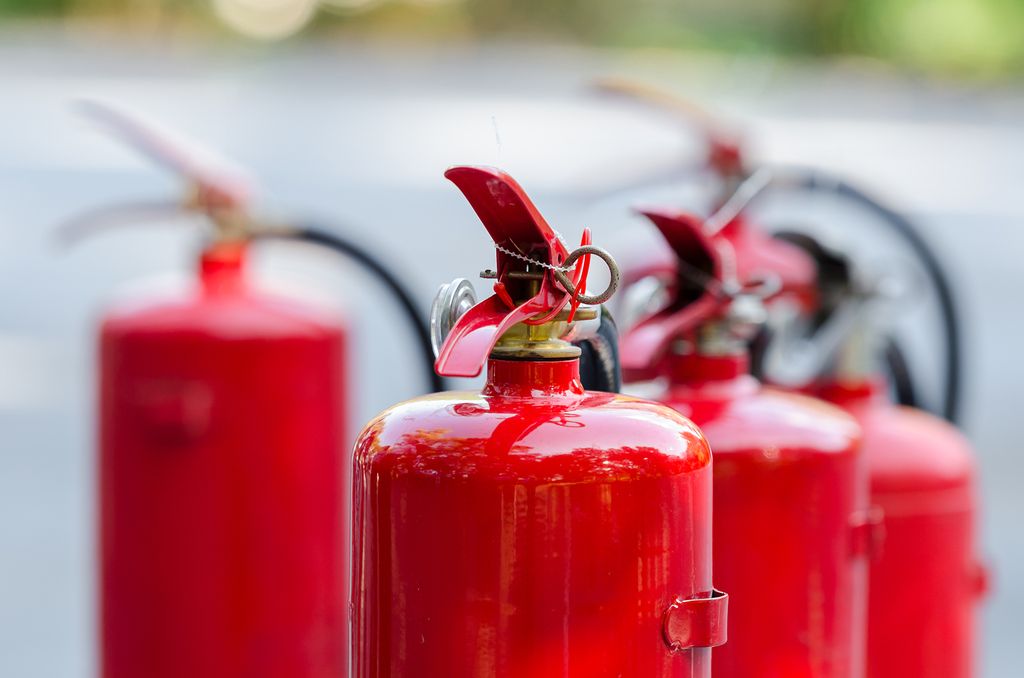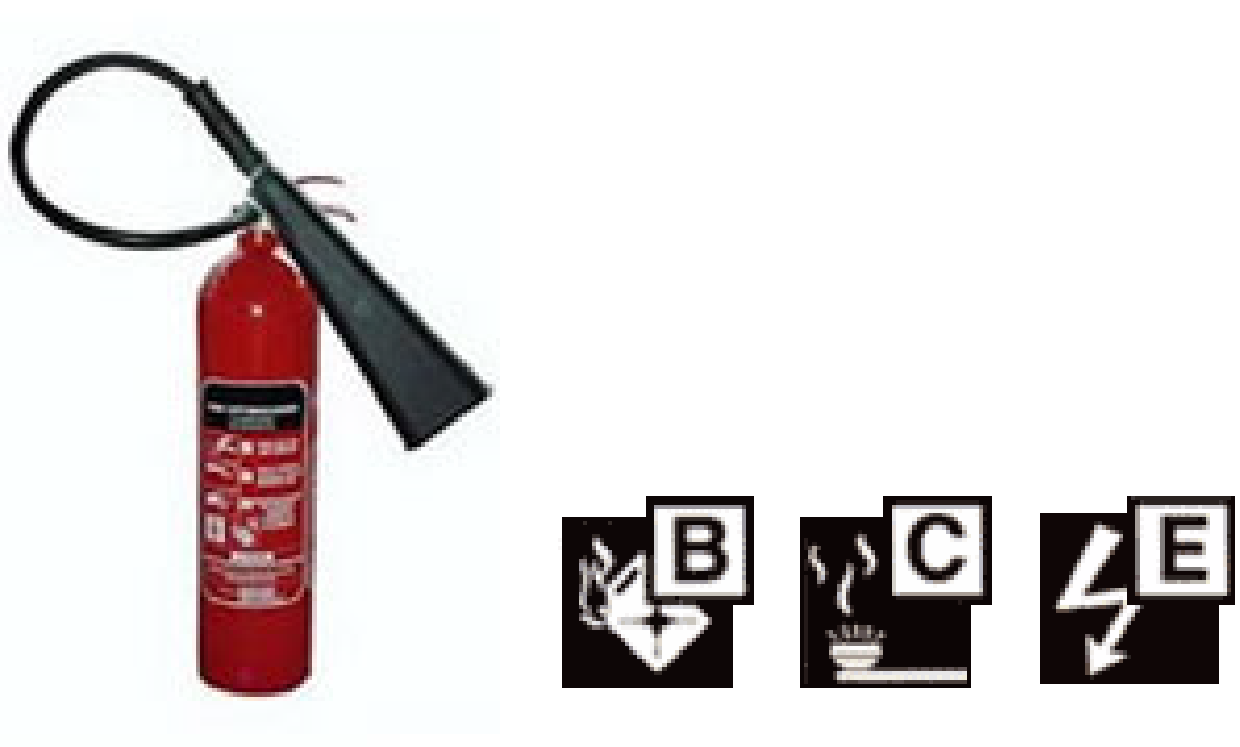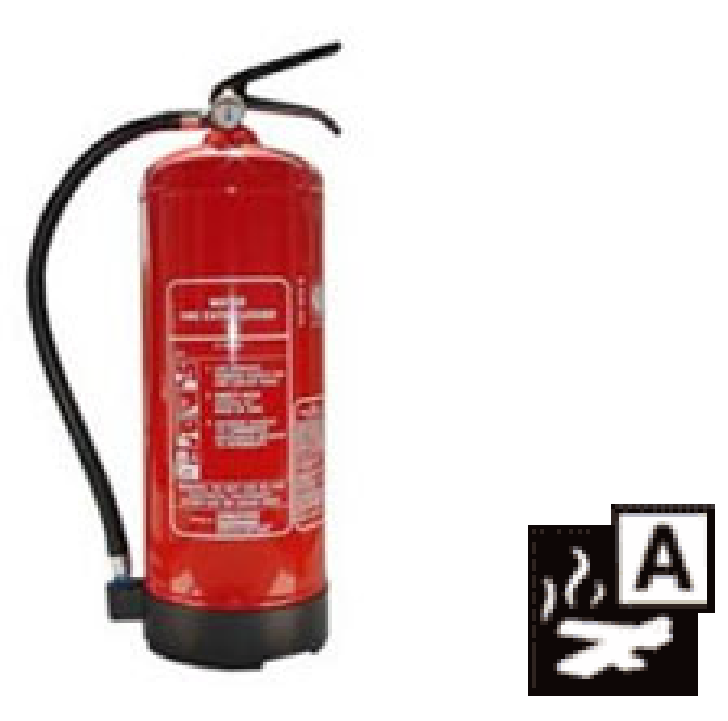Fire Extinguishers

Information on the number of fire extinguishers that you require can be found in the fire risk assessment guides or by contacting an approved fire extinguisher supplier.

Whatever type or make of fire extinguisher you choose, make sure it conforms to the appropriate British Standards (BSEN3 and BS7863). Look for the Kitemark or the special British Approvals for Fire Equipment (BAFE) mark.
Which fire extinguisher should you use?
Carbon dioxide (CO2)

Colour
Black
Danger
Warning: The extinguisher emits a loud noise when started.
Do not use on domestic chip or fat pan fires. This type of extinguisher does not cool the fire very well and you need to watch that the fire does not start up again.
Fumes from CO2 extinguishers can be harmful if used in confined spaces. Ventilate the area as soon as the fire has been controlled. Do not hold the horn while using the extinguisher as it becomes very cold.
How it works
A carbon dioxide extinguisher works on class B and C fires and works by suffocating the fire. Carbon dioxide will not burn and displaces air.
Best for
Live electrical equipment when it is not possible to isolate the electric supply; flammable liquids such as grease, fats, oil paint, petrol etc., but not on domestic chip or fat pan fires.
How to use
Direct the discharge horn at the base of the flames and keep the jet moving across the area of the fire.
Dry Powder – multi-purpose

Generally not to be used indoors, unless mitigated by a risk assessment, as the discharged contents could suddenly reduce visibility and impair breathing, especially in confined spaces.
Colour
Blue
Danger
Important: never mix powders – only extinguishers containing the same type of powder should be used at the same time.
Safe on live electrical equipment, although it does not penetrate the spaces in equipment easily and the fire may re-ignite.
This type of extinguisher does not cool the fire very well so care should be taken that the fire does not flare up again.
Smouldering material in deep-seated fires such as upholstery or bedding can cause the fire to start up again.
Do not use on domestic chip or fat pan fires.
How it works
Similarly to almost all extinguishing agents, the powder acts as a thermal ballast making the flames too cool for the chemical reactions to continue.
Some powders also provide a minor chemical inhibition, although this effect is relatively weak. These powders thus provide rapid knockdown of flame fronts, but may not keep the fire suppressed.
Best for
Can be used on fires involving organic solids, liquids such as grease, fats, oil, paint, petrol, etc., but not on chip or fat pan fires.
How to use
Point the jet or discharge horn at the base of the flames. With a rapid sweeping motion, drive the fire towards the far edge until all the flames are out.
If the extinguisher has a shut-off control, wait until the air clears and if you can still see the flames, attack the fire again.
Dry Powder – standard

Generally not to be used indoors, unless mitigated by a risk assessment, as the discharged contents could suddenly reduce visibility and impair breathing, especially in confined spaces.
Colour
Blue
Danger
Important: never mix powders – only extinguishers containing the same type of powder should be used at the same time.
Safe on live electrical equipment, although does not penetrate the spaces in equipment easily and the fire may re-ignite.
This type of extinguisher does not cool the fire very well and care should be taken that the fire does not re-ignite.
Do not use on domestic chip or fat pan fires.
How it works
Similarly to almost all extinguishing agents, the powder acts as a thermal ballast making the flames too cool for the chemical reactions to continue.
Some powders also provide a minor chemical inhibition although this effect is relatively weak. These powders thus provide rapid knockdown of flame fronts, but may not keep the fire suppressed.
Best for
Liquids such as grease, fats, oil, paint, petrol etc., but not on domestic chip or fat pan fires.
How to use
Point the jet or discharge horn at the base of the flames and, with a rapid sweeping motion, drive the fire towards the far edge until all the flames are out.
If the extinguisher has a shut-off control, wait until the air clears and if you can still see the flames, attack the fire again.
Foam – AFFF (aqueous film-forming foam)

Colour
Cream
Danger
Do not use on domestic chip or fat pan fires.
How it works
These are mainly water based with a foaming agent so that the foam can float on top of the burning liquid and break the interaction between the flames and the fuel surface.
Best for
Fires involving solids. Liquids such as grease, fats, oil, paint, petrol, etc., but not on domestic chip or fat pan fires.
Can be used on class A fires but not recommended.
How to use
For fires involving solids, point the jet at the base of the flames and keep it moving across the area of the fire. Ensure that all areas of the fire are out.
For fire involving liquids, do not aim the jet straight into the liquid. Where the liquid on fire is in a container, point the jet at the inside edge of the container or on a nearby surface above the burning liquid. Allow the foam to build up and flow across the liquid.
Foam

Colour
Cream
Danger
Check manufacturer’s instructions for suitability of use on other fires involving liquids.
These extinguishers are generally not recommended for home use.
How it works
These are mainly water based with a foaming agent so that the foam can float on top of the burning liquid and break the interaction between the flames and the fuel surface.
Best for
Fires involving solids. Liquids such as grease, fats, oil, paint, petrol, etc., but not on domestic chip or fat pan fires.
Can be used on class A fires but not recommended.
Less effective than AFFF foam.
How to use
Do not aim jet straight into the liquid.
Where the liquid on fire is in a container, point the jet at the inside edge of the container or on a nearby surface above the burning liquid.
Allow the foam to build up and flow across the liquid.
Water

Colour
Red
Danger
Do not use on burning fat or oil or on electrical appliances.
How it works
Water has a great effect on cooling the fuel surfaces and thereby reducing the pyrolysis rate of the fuel.
Best for
Fires involving organic solid materials such as wood, cloth, paper, plastics, coal etc.
How to use
Point the jet at the base of the flames and keep it moving across the area of the fire. Ensure that all areas of the fire are out.
Water Spray

Colour
Red
Danger
Do not use on burning fat or oil or on electrical appliances.
How it works
Water has a great effect on cooling the fuel surfaces and thereby reducing the pyrolysis rate of the fuel.
Instead of a jet nozzle, a spray nozzle with a higher pressure is used, creating a fine spray . This allows for a given quantity of water to have a considerable increase in the surface area presented to the fire which makes extinguishing more efficient by more rapid extraction of heat, formation of steam etc.
They can also contain surfactants which help the water penetrate deep into the burning material, increasing the effectiveness of the extinguisher.
Best for
Fires involving organic solid materials such as wood, cloth, paper, plastics, coal etc. Size for size, they offer up to 300% more firefighting capability than traditional jet-type water fire extinguishers. Available in 3 and 6 litres.
How to use
Point the jet at the base of the flames and keep it moving across the area of the fire. Ensure that all areas of the fire are out.
Wet chemical

Colour
Yellow
Danger
Check manufacturer’s instructions for suitability of use.
These extinguishers are not recommended for class B fires and home use.
How it works
Most class F extinguishers contain a solution of potassium acetate, sometimes with some potassium citrate or potassium bicarbonate.
The extinguishers spray the agent out as a fine mist. The mist acts to cool the flame front, while the potassium salts saponify the surface of the burning cooking oil, producing a layer of foam over the surface. This solution thus provides a similar blanketing effect to a foam extinguisher but with a greater cooling effect.
The saponification only works on animal fats and vegetable oils, so class F extinguishers cannot be used for class B fires. The misting also helps to prevent splashing the blazing oil.
Tests have established that a six-litre extinguisher is capable of extinguishing a fire in a 75-litre capacity deep-fat fryer.
The extinguisher is easy to use producing a gentle but highly effective spray.
Best for
The specialist wet chemical extinguishers are ideal for class F fires involving cooking oils and fats such as lard, olive oil, sunflower oil, maize oil and butter.
How to use
Apply the wet chemical using the extended applicator in slow circular movements, which gives a gentle, yet highly effective application.
Apply the fine spray on to the burning fat until the surface of the burning cooking oil changes into a soap-like substance, which prevents re-ignition. The gentle application helps prevent hot oil splashing onto the user.